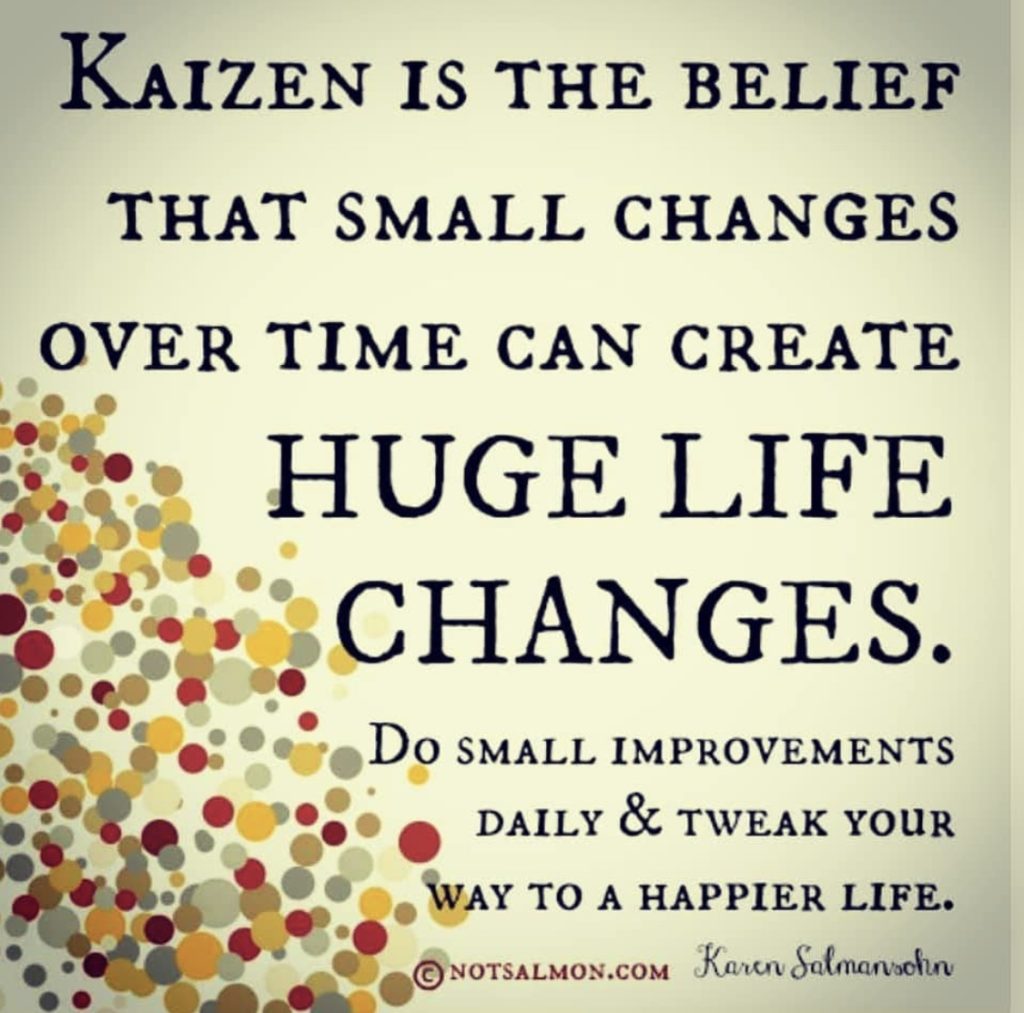Taking a page from the business world, I want to introduce you to the Kaizen approach to habit change.
Maybe you have tried to change habits before and it looked something like this.
On January 1st you threw out half the food in your pantry and bought a couple hundred dollars worth of exercise clothes, planning to exercise every day before work. The first week of your person New Year New You Revolution was uplifting as you imagined how you would look in 6 months.
The second week was less fun because your whole body hurt, and you were exhausted from getting up at 5:00 am to start your personal revolution. Not to mention damn hungry all the time.
The third week you threw out the healthy eating idea because the universe did not seem to understand the idea of a new you and still threw nonsense at you that drove you to the candy aisle.
By the end of the third week, you quit exercising because if you are going to emotionally eat so much candy, what use is the gym. Who needs a revolution anyway?
The Kaizen Approach
Many organizations in corporate America embrace the Kaizen approach to continuous improvement. Instead of throwing out everything they do today and implementing a new system, they make small adjustments on a regular basis – daily even. Kaizen is a Japanese term for continuous improvement and is a strategy used by most managers in Japan. It consists of five elements:
- teamwork
- personal discipline
- improved morale
- quality circles
- suggestions for improvement
In Japanese companies, such as Toyota and Canon, a total of 60 to 70 suggestions per employee per year are written down, shared and implemented. In most cases these are not ideas for major changes. Kaizen is based on making little changes on a regular basis: always improving productivity, safety and effectiveness while reducing waste.
VSRD-IJBMR, Vol. 1 (3), 2011, 177-184
Kaizen Habit Change
Many attempts at habit change fail because of taking on too much at once – as you saw in the previous example. A more Kaizen approach would be to make healthy substitutions or modifications instead of throwing out half of the food in the pantry.
- Instead of a large latte, order a medium latte.
- Swap ranch salad dressing for a vinaigrette.
- Add a side salad to dinner once a week.

A more Kaizen approach to starting an exercise program would be to add small bouts of physical activity instead of buying a whole new workout wardrobe and planning for daily workouts. Some suggestions could include:
- Adding a dog walk to your after dinner routine on Sundays.
- Doing 1 set of pushups or other body weight exercises.
- Instead of eating at your desk through lunch, spend 10-15 minutes of your lunch break walking. Even if it is the parking lot.
Once these small changes become part of your daily activities, you can start to build. Add a side salad to a second night per week. Add another set of strength training exercises. Increase your lunch time walk to 20 minutes. But just pick one – you don’t have to overhaul overnight. Kaizen discourages this. And so does Sustainable Productivity.
Kaizen to a Sustainable You
I encourage you to consider if a habit change you are considering is Sustainable Productive. A habit can be sustainable and not productive. I am looking at you, Netflix binge. But it can also be productive and not sustainable. In the example that started this blog post, getting up at 5:00 am was not sustainable, although it seemed productive.
The sweet spot where these two overlap is Sustainable Productivity – activities where you can continue lifelong if you want to.
Sometimes it is hard to determine what Sustainable Productivity is for yourself – you are just too close to it. I have heard from readers that they don’t know where to start or what the next right step is.
So I have created the Sustainable You course. It is a 5-part self-paced program that teaches you the pillars of Sustainable Productivity, including components of each. You will learn about how each component contributes to a Sustainable You and what potential adjustments could be. You also will learn about why habit change may not have worked for you in the past and what to do to make this time different. Hint: Kaizen – or small, sustainable changes – are a key component!
Start today to create a life you don’t need to escape!
Leave A Comment